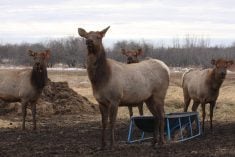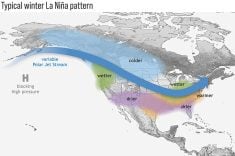In addition to saturated fields, western Canadian canola growers face another threat this summer – diamondback moths.”Significant populations have moved in early. It’s something that people need to really watch out for,” said John Gavloski, an entomologist with Manitoba Agriculture.Provincial government monitoring programs indicate the moths are present across the southern Prairies. They also arrived early this year, in mid-May, giving the insects more time to reproduce and establish a large population.”Diamondback moths will be a threat this year. You can’t ignore it,” said Scott Meers, Alberta Agriculture insect management specialist, who added the province maintains 20 pheromone traps across Alberta.”We have a couple sites that are high and over half of our sites have caught at least some diamondback moths,” he said.In Saskatchewan, trap counts indicate the moths are present in the southern half of the province, said Scott Hartley, pest management specialist with the province.Diamondback moths become a pest on the Canadian Prairies about once a decade, Gavloski said. They typically winter in Texas and northern Mexico, feeding on cauliflower, broccoli and other vegetable crops. Strong southern winds blow the moths into Canada, where it takes about three to four weeks for them to go through a life cycle.The larvae threaten canola at this time of year because they feed on the leaves of seedlings. If there is more than 25 percent foliage damage to seedlings, it’s considered a threat to yield, Gavloski said.Later in the growing season, the larvae feed on foliage and pods. They can cause economic losses if there are more than 20 to 30 larvae per square foot, Gavloski added.The larvae are yellow to green, one centimetre long and relatively easy to identify.”They have this bizarre behaviour where they wiggle right crazy, they go real snaky, when you disturb them.”At this point in the season, it’s hard to say for certain that diamondback moths will cause a problem for canola growers, Gavloski added. They have arrived early in previous years but didn’t grow exponentially to pest levels.Heavy rains in late May might have slowed down the moths, because the larvae will drown in pools of water if rain knocks them off the plant, he said.
Read Also

Canadian Food Inspection Agency extends chronic wasting disease control program consultation deadline
Date extended for consultation period of changes to CWD program















